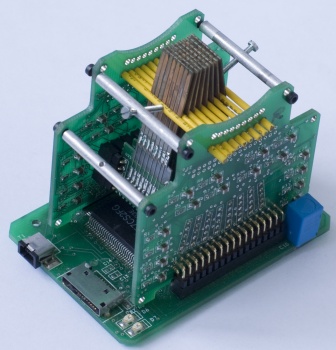If You Can't See it, Feel it!

Have you ever stared at something so long that you started to think it was actually moving? You're not crazy! This is actually an illusion called "motion aftereffect". Nine years ago in the year 2000, neurologist Christopher Moore, at MIT in Cambridge, found that when a device vibrated onto a subject's fingertips there was activity seen in the visual motion detector in the brain. These findings were dismissed because prior to these unusual, "unimportant" results, everybody thought the brain processed the senses on their own and combines the senses when the brain interprets them.
So much for tossing these results! For the past five years motion aftereffect has been research thoroughly. This first started using blind subjects and observing the brain interactions when the subjects read Braille. The Braille actually triggered the brain's visual cortex. These results were written off by saying that the brain was working to compensate for the blindness. However, this wasn't enough for Moore and another graduate student, Talia Konkle, and they researched some more. They wanted to know if this occurred in people that didn't suffer from blindness.
With the help of "DaVinci", a small tactile simulator that taps patterns with a centimeter box of pins on the subjects' hands, they could answer some questions. Eight subjects watched a whit screen as dark stripes fell across it. After viewing the stripes the people felt DaVinci tap the pins across their fingertips while they viewed a stationary stripe. Surprisingly, motion aftereffect transferred between senses in the brain. Those who watched the moving stripes thought the pins were moving across their fingers while those who watched the stationary stripes felt the opposite sensation from DaVinci.
These findings suggested a deeper connection between the senses rather than working on their own and then being put together when it came to how our brain perceives things. In other words, what we touch might slightly alter what we see. Moore and Konkle are trying to use their results to find exactly where in the brain the sensory interaction happens. They will eventually try to use these facts to help in rehabilitation approaches for stroke victims or victims of other brain injuries that impair vision and/or touch.
Crystal Cabral (Group A)
Update: Wow, sorry about the spelling errors. I did this really late at night it's not very like me to post something with so many errors. Pretty embarrassing. Aside from that, it seems like many people think this is hard to believe. I don't necessary believe all of it as well, but I'm sure if I were to pay more attention to things like this I'd notice it and understand it better.

3 Comments:
It's weird to think that the things we touch might alter what we see. I often think that things are moving wheni'm pretty sure they not, maybe its somethink im touching that influencing my sight. Interesting blog!
Samantha DeBiasio
I don't quite buy into things I'm touching being able to noticeably alter my vision. I don't think the original data was considered unimportant, but more likely erroneous if there was already a dominant scientific idea floating around.
A spell check would solve a lot of the errors.
Nick Cline
I've had this/something like this happen to me at least a few times that I can remember. The article mentions that it was previously thought that the body processed the senses and then tries to interpret them, but doesn't mention how the system is NOW thought to work. Is perception merely the final stage of sensing something, or is it pieced together sense by sense?
-Conor Stenerson
Post a Comment
<< Home